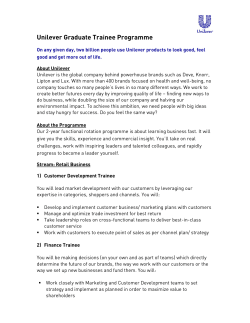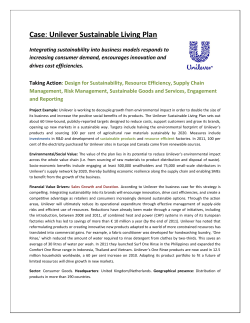
How to Develop Sourcing Strategy
How to Develop Sourcing Strategy Hints and tips for experienced sourcing practitioners in buy-side organizations Howard Spode (www.bpopronet.com) (Written when Howard was Managing Director, Advisory Services, at NelsonHall, and extracted from his NelsonHall publication Developing BPO Strategies) NelsonHall Ltd. Atrium Court The Ring Bracknell Berkshire England RG12 1BW +44(0)8707705967 www.nelson-hall.com INTRODUCTION There is a great deal of activity in business process outsourcing (BPO) and offshoring, and whilst these interventions can be extremely powerful in delivering significant gains in organizational effectiveness and/or efficiency, neither is a “cure for all ills”. Mistakes happen and when they do, they can be costly. In our experience, sometimes this is because a particular project has not been thought-through well enough. To avoid this problem, we advocate in every case the development of well-founded evaluation of the potential change, evolving, if appropriate, into a strong justification for that change. This we call a “sourcing business case”, and we describe our approach to this topic in other documents (see below for details). At other times, BPO and offshoring fail to deliver the benefits expected of them for a different reason. This is where, although individual sourcing projects might be well-founded, there is insufficient overall linkage of different sourcing projects within an organization. Specific arrangements are put in place on a piecemeal basis, which leads to the establishment of management infrastructure that is more costly than necessary (given different commercial terms, different monitoring mechanisms, etc) and, at worst, to some deals being out of line with top-level strategy and therefore value-destroying in a very real sense. Our response to this problem is to advocate the development of “sourcing strategy” - a macro-level view of the drivers and guiding principles for specific sourcing activity within an organization. This is what we cover in this document. As will already be evident, we use the term “sourcing” to cover BPO and/or offshoring. And, for further clarification at the outset of this paper, we should state that, to us, the scope of BPO is limited to the “business support services” – ie front-office (eg contact centre), “middle-office” (ie industry-specific operations, such as check clearing in a bank) and “back office” (eg accounting, HR, IT, etc). This document presents our advice (in summary form) on how to develop sourcing strategy. The contents are extracted from the NelsonHall publication “Developing BPO Strategies”, a practitioner guide which covers both sourcing strategy and sourcing business cases (ie evaluations/justifications of specific sourcing propositions, as introduced above). Developing BPO Strategies is a substantial piece of work which combines theory, research and case-study experience to clarify the key concepts, introduce powerful methodologies and identify best practices and lessons learned. We are anticipating that it will become a key resource in an industry where there is a lack of consistency over approaches and terminology and where poor decision-making is still all-too-common. This How to Develop Sourcing Strategy does not include background theory or case studies. Its purpose is to be a source of handy hints and tips for experienced sourcing practitioners in buy-side organizations and it simply: • Introduces our sourcing strategy methodology (Section 1) • Explores key lessons learned at each stage of the methodology, as drawn from a series of interviews with experienced sourcing professionals (Section 2) • Describes how to get further support from us (Section 3) 2 NelsonHall. For information only. Not to be distributed or used for any other purpose without prior written permission. 1.0 INTRODUCTION TO SOURCING STRATEGY METHODOLOGY As we mentioned above, sourcing strategy is a macro-level formalization of the drivers and guiding principles for specific sourcing activity within an organization. Sourcing strategy sets the context and parameters for activities to evaluate/justify/implement/operate specific sourcing initiatives and links specific sourcing activity together to form a cohesive whole. Sourcing strategy is driven by top-level strategy, interacts with functional strategy and sets the context for specific sourcing propositions/projects in the manner shown by the graphic to the right. The steps we recommend to develop sourcing strategy are sown in the following graphic: In narrative terms, this means: • Interpret “top-level strategy” and “functional strategy”. Ultimately, all proposed organizational change should be evaluated in the light of the organization’s mission, vision, values and strategic objectives (“top-level strategy”). This in turn flows down into “functional strategy” – ie the strategy of the Finance function, for example, or IT, or HR. Such strategy includes the vision for the function’s influence of the organization as a whole, the vision and mission for the function itself and, often directly relevant to sourcing, the intentions for optimizing the effectiveness and efficiency of functional operations. • Review “current operations”. Once strategic context is clear, a critical assessment of the effectiveness and efficiency of current business support operations needs to be undertaken. This is carried out in terms of dimensions such as process, technology, organization, physical infrastructure and people. • Specify the “need for change”. This is not the solution at this stage, but a statement of the criteria and parameters that possible futures will have to adhere to, determined in the light of the strategic context and the review of current operations. • Undertake a “review of the external trends and best practices” - ie “explore the art of the possible”. Is there a viable supplier community? What deals are other organizations doing? What are the lessons? 3 NelsonHall. For information only. Not to be distributed or used for any other purpose without prior written permission. • Envision to-be models, comprising: “operational model” (“how would sourcing work in the organization?”), “commercial model” (“what parties would be responsible for what?”) and “transition approach” (“how would we move from the as-is to the to-be?”). • Identify the “risks” associated with the to-be models and develop risk management actions. • Draw the conclusions by comparing as-is with to-be in order to determine the organization’s “stance and philosophy on sourcing” – will the organization embrace sourcing? Under what circumstances? What kind of activities will be evaluated for sourcing? What are the key policies and parameters to govern sourcing activity? • If appropriate (ie if there is a positive stance on sourcing), lay out the “implementation route map” what needs to happen to bring the desired landscape about? Support mechanisms? Initial projects? 4 NelsonHall. For information only. Not to be distributed or used for any other purpose without prior written permission. 2.0 KEY LESSONS LEARNED AT EACH STAGE OF THE METHODOLOGY NelsonHall recently conducted a series of interviews with experienced sourcing professionals in a wide range of organizations (public sector, financial services, manufacturing, media content, etc.) to ask for their lessons learned and recommended best practices on developing sourcing strategy. The key, summarized outputs are as follows: • Sourcing strategy is often developed following the evaluation/implementation of a number of (successful and/or unsuccessful) specific sourcing projects. Although not an ideal state of affairs, this is a quite natural occurrence. The requirement for having a high-level sourcing strategy at all might not be obvious before actual sourcing projects have been investigated and/or implemented. Even if the logic is accepted, this might not prove enough of a justification for making the investment and incurring the elapsed time required by the process of developing the sourcing strategy. However, a sourcing strategy will definitely be needed if anything more than a minimal amount of sourcing activity is anticipated within an organization. • The link between sourcing strategy and business strategy needs to be made clear. It only needs to be done once, but it does need to be done. This is something that is so obvious that sometimes it doesn’t get done! But the link is crucial for: i) shaping the sourcing strategy correctly, ii) getting senior stakeholder support, iii) internal communications. • When an organization has reviewed sourcing as a concept and decided that it wants to embrace it, sourcing strategy then becomes a vehicle for encouraging, guiding and supporting sourcing activity. This is analogous to the process by which a business case is first about evaluation, then, if the case if proven, about justification. In terms of guidance and support, sourcing strategy can contain policies and parameters for: opportunity identification, decision-making, preferred suppliers, preferred locations, business standards. An example of a set of guiding principles follows: • It is important to be very clear about the objectives of specific sourcing activity. Often core objectives (say cost reduction, for example) are “dressed up” with other objectives (eg quality improvement). Sometime this is for reasons of softening the communication message internally, at other times it is because the organization feels that it can get away with it in that a potential supplier will accept the additional objectives in order to win the business. Two well-known but often neglected organizational mantras come into play – the first (from HR) is: “say what you mean and mean what you say” and the second (from Procurement) is: “don’t get greedy”. • Every specific sourcing decision needs to be based on a solid business case. This principle should be laid down clearly in the sourcing strategy and enforced through the sourcing 5 NelsonHall. For information only. Not to be distributed or used for any other purpose without prior written permission. infrastructure. And decision-making criteria at the business case level should be limited to genuine business drivers (as opposed to personal preferences/prejudices) • Sourcing strategy needs to work at a macro level. As an illustration of this, here is an example of how one organization went about identifying possible areas for sourcing activity (to be subject to formal business cases at the next stage). With the help of a number of key, high-level facts and interpretations worked by a project team, a group of key stakeholders from the organization’s business support functions gave came together in a workshop to give their opinions on the health of the various business support operations. Each operation (A-G in the table below) were scored in terms of effectiveness, efficiency, risk, ease of fixing, impact of change, competitive advantage and risk to brand. (NB: the extent to which a process interacts with external customers is often a key consideration. In this case, this consideration was picked up under “risk to brand” and “effectiveness”). Note how some of the criteria have been worded “in reverse” in order to keep the scoring system consistent. These ratings were then plotted on a matrix, with the average of the first five criteria displayed against that on the latter two, given that the first five criteria drive sourcing, whereas the latter two resist it. The matrix clearly shows that some operational areas have strong drivers for outsourcing and relatively weak inhibitors (those in the areas colored green), whereas some have strong inhibitors and relatively weak drivers (those in the areas colored red) and some (in the areas colored amber) are somewhere in between. In this case, operational areas G, A and E were prioritized for further investigation. • The supplier-selection process laid down in the sourcing strategy needs to be one geared on “strategic alignment” between client-organization and supplier, as opposed to “traditional purchasing”. For example – are a supplier’s overall business objectives consistent with the 6 NelsonHall. For information only. Not to be distributed or used for any other purpose without prior written permission. specific objectives of the deal objectives, are organizational values and working culture in line, is there a good working relationship between the people who will need to work together? • Building and maintaining effective access to market knowledge and specialist skills is important, through relationship with BPO analyst and advisory firms, but it is important to get best value from spend, limiting time-based fees on consultants to circumstances where they are absolutely necessary, and ensuring that skill-transfer to in-house employees is in place wherever appropriate • Pace, momentum and flexibility are key, notwithstanding the (valid) emphasis on detailed analysis and clear guidelines for sourcing. This may sound oxymoronic, but examples would include: - Making do with high-level (but robust) data to support the development of sourcing strategy, as opposed to the more detailed analysis required at business case level - Managing expectations that sourcing projects and operations will probably not be 100% “right”. This does not imply complacency in objective-setting, but pragmatism in benefits-realization - Pushing ahead even if all desired stakeholders cannot directly involved in key sessions, eg through use of quorum rules, authorized representatives, pre- and post-session one-on-one communication • Like any standardized procurement process, there is a problem with lack of compliance or “leakage”, with executives entering into non-standard arrangements. This is especially in large, complex organizations where it can be difficult for a small, newly-formed central team to gain visibility/influence over all sourcing activities. • Formal organizational arrangements to support sourcing are crucial. This might include a dedicated sourcing team, a senior sourcing council, sourcing to be “an agenda item” (however small) at the organization’s top management level and personal objectives for sourcing assigned to individual line-executives. One organization’s management structure for sourcing is as follows: • Sourcing strategy needs to continually search for new opportunities, because those for “traditional” FTE-intensive function-specific deals are finite within any organization and will become exhausted relatively quickly if the organization embraces sourcing actively. New opportunities might be provided by cross-functional processes (eg document management) and spend-intensive (as opposed to FTE-intensive) ones (eg non-core procurement). 7 NelsonHall. For information only. Not to be distributed or used for any other purpose without prior written permission. 3.0 WHERE TO GET FURTHER HELP NelsonHall helps organizations make better decisions about BPO. We do this be providing cost-effective access to our research-based insight - we are the world’s leading BPO analyst firm. We are not BPO suppliers, nor do we actively promote BPO in all cases - we simply provide independent, objective and unbiased information to empower our clients’ decision-making processes. There is a huge amount of activity taking place in BPO, but, whilst it can be an extremely powerful proposition, it is certainly not a cure for all ills. Mistakes happen and they can be costly. Decision-making therefore always needs to be based on rational analysis by informed executives. However, it is extremely difficult for in-house teams to access the valid information they need - the industry is complex and fastmoving, suppliers (and consultants) have vested interests and the various would-be advisors charge high fees. Our service overcomes all these challenges. Each of our global team of researchers is hard-wired into a key area of BPO. They possess a complete picture of what is feasible in terms of operational solutions, what is reasonable in terms of commercial models and who-can-do-what in terms of supplier capabilities. Our service-package consists of: • On-demand (web-based) access to our extensive and constantly-growing library of written research • An unmetered hotline to our analysts for interpretation and advice • Free support for mini-projects that would be charged for by other companies (eg compilation of shortlists of potential suppliers) No other source of information can match the rigour or value-for-money that we provide. Right now we are helping executives across the globe to unravel the complexities of the industry, base their decisionmaking on reality and, where appropriate, engage with the market from a position of strength. For more details and for feedback on and/or discussion about this Practitioner Guide, please contact us: NelsonHall Ltd Atrium Court The Ring Bracknell Berkshire England RG12 1BW +44(0)8707705967 www.nelson-hall.com NB: We also provide some of our insight for free – in the form of a monthly newsletter and regular public webcasts on specific topics. Please see our website for details and feel free to register. 8 NelsonHall. For information only. Not to be distributed or used for any other purpose without prior written permission.
© Copyright 2025














